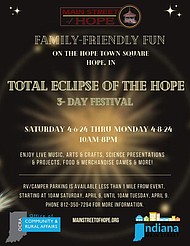April 4, 2018 at 5:30 p.m.
Bud Herron: Loss of barber shops hair-raising development
In my childhood and teen years, Hope had five barber shops.
Ira Carman cut hair at his house on Washington Street across from the school, as did Clarence "Chick" Burch on Walnut Street, just north of Washington. Kenny Frazee ran a shop on the east side of the town square, Wallace Wright clipped along in a little stand-alone building on the south side of the square, and young "Buck" Imlay eventually joined the party at a shop on the west side of the square.
Each barber had a customized set of faithful customers - each of whom would swear by that man's mastery of the craft, the short waits and the reasonable prices. In truth, however, no one became a regular customer of any of these barbers because of the haircuts. Customers chose barbers based on conversation - who provided the best chit-chat and who led the best "group therapy" sessions for those waiting their turn.
The late 1950s and early 1960s was not a time when men let their hair down much to express their deepest thoughts, if they ever had any. It was a time filled with a lot of scratching, spitting, belching, equipment adjusting and back-slapping.
But at the barber shop each week, we could escape from all those women who tried to put social rules on us and just be... well, just be our unacceptable selves.
Of course, we were unacceptable in a variety of ways, so the ambiance of each barbershop varied a lot - which was the only reason to have five barbers in such a small town.
Carman catered to the over-40 crowd of hunters and fishermen. His in-home shop was a place where a memory of of a 30-pound bass or a 50-point buck brought no more than an affirming nod.
Burch cut the hair of very small boys who had no choice and men well past 60 who had no time urgency apart from trips to the bathroom. He was perfect for men who wanted to look as if they were about to leave for service in World War I. "Chick" also sold insurance and was known to stop in the middle of a haircut and eat lunch or supper whenever his wife called from the other room.
Wright attracted a mix of customers who didn't hunt, fish or have any plans to fight against the Kaiser in France. He also was fairly fast and didn't talk much. Kids whose moms took them to the barbershop usually went to Wright. The magazines available were "Boy's Life" and "Humpy-Dumpty" and the conversation was of the Sunday school variety.
Frazee was the choice of the teens in the late '50s and early '60s because he was the first, local master of the "flattop" - a style that required a lot of wax and a barber with patient, steady hands. Carman, Burch and Wright refused, at first, to give it a shot, siding with the parents who said the whole idea was as stupid, maybe even as communistic, as fluoridated water and pegged jeans.
Then along came Darryl "Buck" Imlay - just out of barber school and not long out of Hauser High School. Buck opened a shop on the west side of the square and brought "cool" to the town. He could do the flattop, the Hollywood burr or ducktails with equal flair.
Buck could lead the conversations on any sports team or sporting event, could tell a good joke and could offer solid advice on how to get along with women without accepting all their rules.
(Rumors also said he had a "Playboy" magazine wrapped in a "Newsweek" cover. Evidently, if the shop was clear of younger kids and you were at least 16, you could take a peek, if he trusted you to keep your mouth shut. Of course, I do not know that for a fact and I never saw the magazine myself.)
Buck soon was the barber for about every man in town over 10 and under 40. On Saturday mornings after a high school basketball game, seats in the shop were as scarce as seats had been the night before in the Hauser gym. Depending on the outcome, Buck could lead the celebration or the wake.
I left town to go to college the same year the Beatles invaded our nation and began destroying the hair-cutting business with their long hair. The '60s "hippie look" also took hold and then became the "country redneck look" and eventually the hair of the younger men no longer required cutting, or in a lot of cases, even washing.
Today there are no barbershops in Hope. The men who still get haircuts here go to one of the beauty shops. Some of the men also get their hair "styled" in one of the Columbus "unisex" clip joints, swing by Centerstone for therapy then drive home and converse with each other on their Facebook pages.
Pardon me, but even waiting, half shorn, while "Chick" Burch sold an insurance policy or ate lunch was better than that.[[In-content Ad]]
